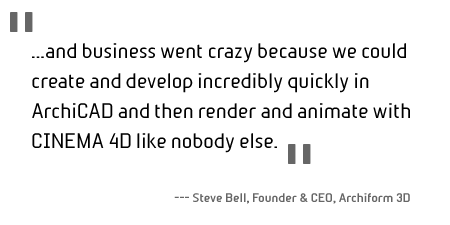It has been an absolute pleasure to have been introduced by Maxon to the work of Steve Bell and his colleagues at Archiform 3D. We knew of course right away that Steve was a CINEMA 4D expert user–because Maxon was excited to tell us about his work–but what we didn’t anticipate fully was how interesting the Archiform 3D story really was.
Advertisement
Steve is not just one of the “grandfathers” of architectural visualization, he’s a leader of a global consulting practice and a model for how inspiring young 3D professionals might want to shape their career. I say this not just because Steve has been very successful, or because he has a global client roster that includes the likes of Porsche, CBS Sports, HGTV, Four Seasons and more, but because of the way he has adapted himself, his views, his practice and his methods over the years in response to global business change.
A consummate artist who loves the detail and tech behind the craft, Steve prefers to keep his business intimate and small, working alongside the talented Bianca Miller, and a small globally dispersed set of ArchiCAD and CINEMA 4D experts. He explains in the interview how Archiform 3D delivers its value to its global clients and how it relates to the work being done inexpensively in China.

01 – Four Seasons Kuwait project image of a hotel lobby is an example of the type of talent coming out of Archiform 3D with combined backgrounds in architecture and interior design. Models are created in GRAPHISOFT ArchiCAD and final rendering visualization and animation is done in Maxon’s CINEMA 4D.
From his nascent beginnings with an Atari computer to his 40 plus machine Xserve-controlled private render farm, from life down under to commuting to the Miami office in his yacht, Steve shares his views on how he works, what his clients value, and what he thinks about his favorite technology. He even shares his perspective on Apple’s newest Mac Pro and he doesn’t mince words.
Background and Beginnings
AFR (Anthony Frausto-Robledo) : Can you tell me a little bit about your background in this industry, how did you get started in this field?
SB (Steve Bell) : Well…that’s going back a long time. I’m kind of one of the grandfathers of the industry now. I was very happily designing buildings and houses for a very long time in Australia and was one of the very first to make the break to CAD. And back in those days the choices were quite limited. Mac hadn’t really set in, PC wasn’t entrenched like it eventually became. The first thing I got was an Atari machine and our earliest CAD solution was DynaCAD.
It was limited in what it could do, so we started writing our own programs that would take 2D data and convert it to 3D data and come up with nice perspectives because everything was orthographic at the time. So we ended up doing really well because nobody else had this capability. And then, one day, ArchiCAD came to my attention.
AF: And what impact did that have on you?
SB: Well…it could not only do true 3D it had a beautiful interface–I mean there was absolutely nothing like it at the time. And we could also use our programming experience to customize it. And we did.
AF: So I take it the Atari experienced ended quickly.
SB: Yes. We were running on Apple Mac with ArchiCAD and then we adopted Artlantis. We were doing very well doing renderings with that for awhile and then we ended up pushing up against the boundaries of that. So we looked at CINEMA 4D. And the Macs kept evolving as well–and business went crazy because we could create and develop incredibly quickly in ArchiCAD and then render and animate with CIMEMA 4D like nobody else.
AFR: So after you went on your own how many years were you doing both the architectural design practice and the 3D professional business?
SB: I was probably doing both for just a few years. We started using CAD and 3D about 25 years ago. And from there it just grew and went to the US, Europe and the Middle East. And then two things happened. The global market crash and China…everybody with their expectations of the two hundred dollar rendering.
next page: Competing with China – How To Do It Right





Reader Comments
Jade Pearl liked this on Facebook.
Asia Panek liked this on Facebook.
David Silverman liked this on Facebook.
Lucia Lagarda liked this on Facebook.
Comments are closed.